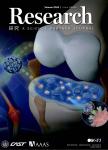An Aerial–Wall Robotic Insect That Can Land, Climb, and Take Off from Vertical Surfaces
作者机构:College of Mechanical and Electrical EngineeringNanjing University of Aeronautics and AstronauticsNanjingChina College of Aerospace EngineeringNanjing University of Aeronautics and AstronauticsNanjingChina State Key Laboratory of Mechanics and Control for Aerospace StructuresNanjing University of Aeronautics and AstronauticsNanjingChina
出 版 物:《Research》 (研究(英文))
年 卷 期:2024年第2023卷第1期
页 面:149-163页
核心收录:
学科分类:0710[理学-生物学] 0810[工学-信息与通信工程] 080202[工学-机械电子工程] 08[工学] 0804[工学-仪器科学与技术] 0802[工学-机械工程] 0836[工学-生物工程] 0811[工学-控制科学与工程]
基 金:the National Key R&D Program of China grant no.2019YFB1309600 the National Natural Science Foundation of China grant nos.51875281 and 51861135306
摘 要:Insects that can perform flapping-wing flight,climb on a wall,and switch smoothly between the 2 locomotion regimes provide us with excellent biomimetic ***,very few biomimetic robots can perform complex locomotion tasks that combine the 2 abilities of climbing and ***,we describe an aerial–wall amphibious robot that is self-contained for flying and climbing,and that can seamlessly move between the air and *** adopts a flapping/rotor hybrid power layout,which realizes not only efficient and controllable flight in the air but also attachment to,and climbing on,the vertical wall through a synergistic combination of the aerodynamic negative pressure adsorption of the rotor power and a climbing mechanism with bionic adhesion *** the basis of the attachment mechanism of insect foot pads,the prepared biomimetic adhesive materials of the robot can be applied to various types of wall surfaces to achieve stable *** longitudinal axis layout design of the rotor dynamics and control strategy realize a unique cross-domain movement during the flying–climbing transition,which has important implications in understanding the takeoff and landing of ***,it enables the robot to cross the air–wall boundary in 0.4 s(landing),and cross the wall–air boundary in 0.7 s(taking off).The aerial–wall amphibious robot expands the working space of traditional flying and climbing robots,which can pave the way for future robots that can perform autonomous visual monitoring,human search and rescue,and tracking tasks in complex air–wall environments.



